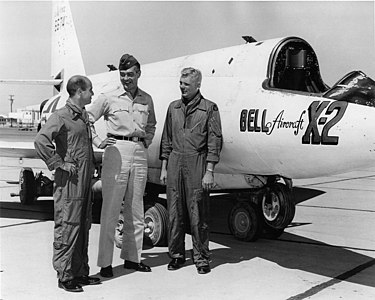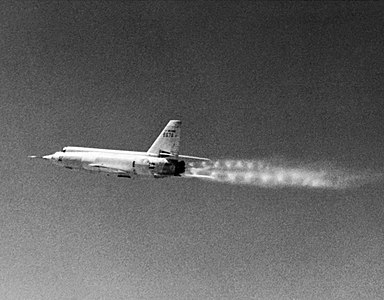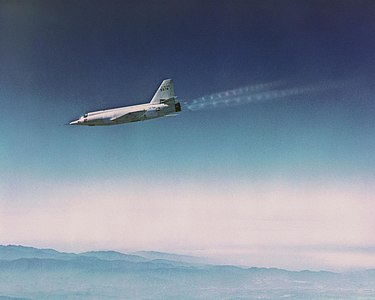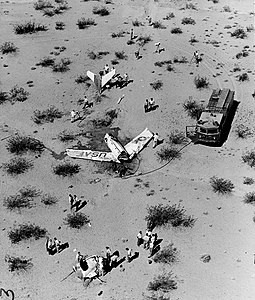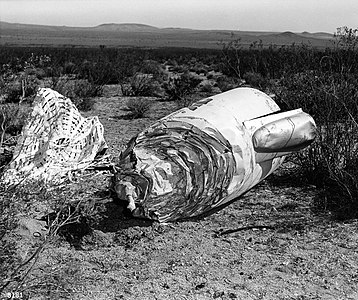Milburn G. Apt
Milburn Grant Apt | |
|---|---|
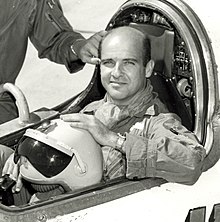 Captain Mel Apt in the cockpit of the Bell X-2 | |
| Nickname(s) | Mel |
| Born | April 9, 1924 Buffalo, Kansas, U.S. |
| Died | September 27, 1956 (aged 32) Edwards Air Force Base, California, U.S. |
| Allegiance | United States of America |
| Service/ | United States Air Force |
| Years of service | 1941–1956 |
| Rank | Captain |
| Awards | |
| Relations | Sharman Apt Russell (daughter) |
Milburn Grant "Mel" Apt[1] (April 9, 1924 – September 27, 1956) was a U.S. Air Force test pilot, and the first man to attain speeds faster than Mach 3.[2] He was killed after separating from the Bell X-2 in his escape capsule during the record-setting flight that exceeded Mach 3.[3] Shortly afterwards, Secretary of the Air Force Donald A. Quarles commended Apt, saying he was "flying faster than any human being has been known to fly."[4]
Early career
[edit]Apt was born April 9, 1924, in Buffalo, Kansas. He graduated from Buffalo High School in 1942. He joined the U.S. Army Air Forces immediately, was sent to flight school, and was commissioned in February 1944. He served with the Caribbean Defense Command until June 1946. In 1951 he received a Bachelor of Science degree from the University of Kansas as well as a bachelor's degree in Aeronautical Engineering from the U.S. Air Force Institute of Technology. He graduated from the Experimental Flight Test Pilot School at Edwards Air Force Base (Class 54B) in September 1954.[5]
Test pilot
[edit]Rescue operation
[edit]Before piloting the X-2 himself, Apt flew chase planes for other test flights. LIFE magazine reported an incident on December 22, 1954, in which Apt rescued Capt. Richard J. Harrer from a Lockheed F-94 Starfire airplane.[6] Harrer's plane had crashed and was on fire. Apt managed to pull Harrer from the wreckage and for his heroism was awarded the Soldier's Medal.
Record-breaking X-2 flight
[edit]The X-2, initially an Air Force program, was scheduled to be transferred to the civilian National Advisory Committee for Aeronautics (NACA) for scientific research. The Air Force delayed turning the aircraft over to the NACA in the hope of attaining Mach 3. The service requested and received a two-month extension to qualify another Air Force test pilot, Apt, in the X-2, and attempt to exceed Mach 3.[7]
On September 27, 1956, Apt made his first and only X-2 flight. The rocket-powered X-2 was launched from a B-50 bomber over the Mojave Desert in California on its 13th powered flight. Apt piloted it to a record speed of 3,377 km (2,098 mi) per hour, or Mach 3.196 at 19,977 m (65,541 ft).[8] Subsequent loss of control from inertia coupling led to the plane's fatal crash.[9]

In the run-up to his first rocket-plane flight, Apt had several ground briefings in the simulator. His simulator training had indicated control difficulties in high-speed flight, and possible techniques for handling them. He launched from the B-50, quickly outdistancing the F-100 chase planes. At high altitude, he nosed over, accelerating rapidly. At 19,977 m (65,541 ft), the X-2 reached Mach 3.196, making Apt the first man to fly more than three times the speed of sound. Upon rocket burnout, Apt found himself farther from home than anticipated. The planned flight profile called for slowing to Mach 2.4 before turning back to base. The additional time to slow before turning may have put him beyond safe gliding range of his planned runway.[10]
Still above Mach 3, he turned back to Edwards. The X-2 began a series of diverging rolls and tumbled out of control. Apt tried to regain control of the aircraft. Unable to do so, he separated the escape capsule. The capsule's drogue parachute opened, but not its larger parachute. Too late, Apt attempted to bail out and was killed when the capsule hit the Edwards bombing range.[11][12][3] According to The New York Times reporting on the event, Lieut. Col. Frank K. Everest, an experienced X-2 pilot, had been critical of the relatively new detachable cabin: "Colonel Everest told reporters in Buffalo that a pilot using the detachable device would be thrown against the instrument panel with terrific force when the parachute braked it. He said some safety had been sacrificed in preference to delaying the X-2 flight tests while the escape mechanism was modified."[3]
The rest of the X-2 crashed unmanned five miles away.[9]

On March 21, 1957, Apt was posthumously awarded the Distinguished Flying Cross, which is given to those who have distinguished themselves "by valor, heroism, or extraordinary achievement."[13][14][15] Prospective X-15 pilots were subsequently shown the on-board film of Apt's fatal crash, taken by a stop-frame camera mounted behind him in the cockpit.[16]
Apt and the X-2 he flew (#46-674)
[edit]-
Apt stands beside the X-2.
-
X-2 pilots Capts. Apt and Kincheloe flank Col. Horace Hanes, AFFTC flight test director (1956).
-
Apt (in cockpit) and Kincheloe.
-
The X-2 at Edwards Air Force Base, surrounded by the B-50 launch aircraft, chase planes, and support crew.
-
The X-2 drops from its B-50 launch aircraft.
-
The X-2 in-flight.
-
The X-2 in-flight.
-
The X-2 inflight, with skids deployed for landing.
-
Crash site in the desert near Edwards Air Force Base.
-
Two pieces of the X-2 at the crash site, five miles from where the escape capsule landed.
-
The X-2's escape capsule at the crash site.
-
The cockpit of the X-2's escape capsule at the crash site.
-
Wreckage from Apt's fatal crash in the X-2.
Personal life
[edit]Apt was survived by his wife and two daughters—aged two and six.[3] One of Apt's daughters, Sharman Apt Russell, grew up to become a writer.[17] She wrote about the significance of his death in an essay in her book, Songs of the Fluteplayer.[18]
References
[edit]- ^ WWII Draft Registration Cards for Kansas, 10/16/1940–03/31/1947, St. Louis, Missouri: The National Archives in St. Louis, Missouri, 1942
- ^ "New Air Mark Seen; X-2 Believed to Have Gone 2,200 M.P.H. Before Crash". The New York Times. 1956-10-18. Retrieved 2021-05-11.
- ^ a b c d "1,900-M.P.H. Rocket Plane Crashes and Kills Test Pilot". New York Times. Vol. 106 (Late City ed.). 1956-09-28. p. 1. Retrieved 2021-05-11.
- ^ "Captain Apt Flew Fastest Before Crash". The Times Record. Troy, NY. 1956-10-10. p. 11.
- ^ Merlin, Peter W. (October 5, 2011). "Starbuster: 55 years ago Capt. Mel Apt conquered Mach 3, lost life on fated flight". Archived from the original on March 4, 2016.
- ^ Wallace, Robert (1956-06-18). "10,000 Men to a Plane". Life magazine. Time Inc. pp. 67–82.
- ^ Gibbs, Yvonne (2015-08-12). "NASA Dryden Fact Sheets – Bell X-2 Starbuster". NASA. Retrieved 2021-05-13.
- ^ "Captain Iven C. Kincheloe Jr". www.af.mil. Retrieved 2021-05-08.
- ^ a b Day, Richard E. (1997). Coupling Dynamics in Aircraft: A Historical Perspective (PDF) (Report). NASA. pp. 8–15. Archived from the original (PDF) on 2020-11-11. Retrieved 2021-05-10.
- ^ Waltman, Gene L. (2000), Black Magic and Gremlins; Analog Flight Simulations at NASA's Flight Research Center (PDF), Monographs in Aerospace History, vol. 20, NASA History Division, p. 138, ISBN 978-0-16-059277-5, OCLC 44869092, SP-2000-4520
- ^ Blair, Clay Jr. (March 1957). "The Last Flight of the X-2". Air Force Magazine. 40 (3). Retrieved November 13, 2012.
- ^ Friedlander, Mark P. Jr.; Gurney, Gene (1973). Higher, Faster, and Farther. New York: William Morrow & Company. pp. 63–65. ISBN 0-688-00204-8.
- ^ "Pilot Gets Posthumous Award". New York Times. 1957-03-21. p. 13. Retrieved 2021-05-10.
- ^ "Distinguished Flying Cross". The Institute of Heraldry: Office of the Administrative Assistant to the Secretary of the Army. Retrieved 2021-05-10.
- ^ "Army Regulation 600–8–22: Military Awards" (PDF). Army Publishing Directorate. Retrieved 2021-05-10.
- ^ Wolfe, Tom (1979). The Right Stuff. New York: Farrar, Straus and Giroux. pp. 202–203. ISBN 0-374-25032-4. LCCN 79-13901.
- ^ Russell, Sharman Apt (Winter–Spring 2009). "Letter to My Father Concerning the State of the World". Terrain.org (23). ISSN 1932-9474. Retrieved October 3, 2013.
- ^ Russell, Sharman Apt (1991). Songs of the Fluteplayer: Seasons of Life in the Southwest. Reading, MA: Addison-Wesley. ISBN 0-201-57093-9. OCLC 22661202.
{{cite book}}: CS1 maint: date and year (link)
Further reading
[edit]- Anderson, John (2014), X-15: The World's Fastest Rocket Plane and the Pilots Who Ushered in the Space Age, Minneapolis [Minnesota], ISBN 978-0-7603-4445-3, OCLC 827257244
{{citation}}: CS1 maint: location missing publisher (link) - Day, Richard E. (1997), Coupling Dynamics in Aircraft: A Historical Perspective (PDF), NASA, archived from the original (PDF) on 2020-11-11, retrieved 2019-10-30
- Davies, Peter E. (2017), Bell X-2., London: Bloomsbury Publishing Plc, ISBN 978-1-4728-1959-8, OCLC 1021807198
- Hallion, Richard P. (1984), On the Frontier: Flight Research at Dryden, 1946–1981 (PDF), Washington, DC: NASA, pp. 87–98
- Jenkins, Dennis R. (2000), Hypersonics Before the Shuttle: A Concise History of the X-15 Research Airplane, Washington, DC: NASA
- Merlin, Peter W.; Moore, Tony (2008), X-plane Crashes, North Branch, MN: Specialty Press, ISBN 978-1-58007-121-5, OCLC 213447807
- Miller, Jay (2001), The X-planes: X-1 to X-45 (3rd ed.), Hinckley [England]: Midland Pub, ISBN 1-85780-109-1, OCLC 47726721
- Van Pelt, Michel (2012), Rocketing into the Future: The History and Technology of Rocket Planes, New York: Springer, ISBN 978-1-4614-3200-5, OCLC 795707071
External links
[edit]- Russell, Sharman Apt. "Letter to My Father [Mel Apt] Concerning the State of the World". Terrain.org. Retrieved 2021-06-11.
- "Capt. Mel Apt Memorial, X-2 Crash Site". www.bellx-2.com. Retrieved 2021-05-12.
- 1924 births
- 1956 deaths
- Accidental deaths in California
- Air Force Institute of Technology alumni
- American aviation record holders
- American test pilots
- Aviators from Kansas
- Aviators killed in aviation accidents or incidents in the United States
- Military personnel from Kansas
- People from Wilson County, Kansas
- United States Air Force officers
- United States Army Air Forces officers
- United States Army Air Forces personnel of World War II
- U.S. Air Force Test Pilot School alumni
- Victims of aviation accidents or incidents in 1956
- Victims of flight test accidents


